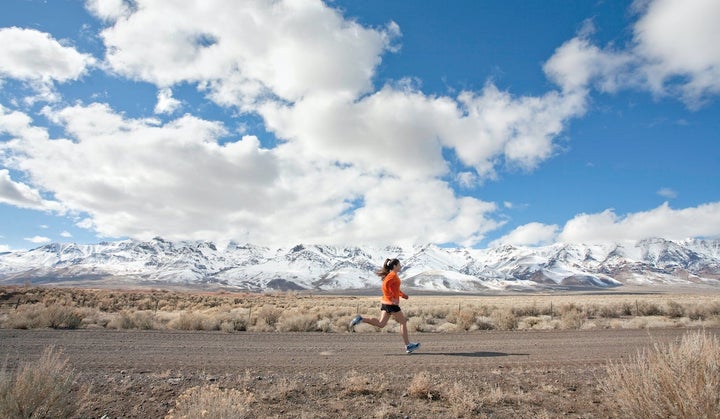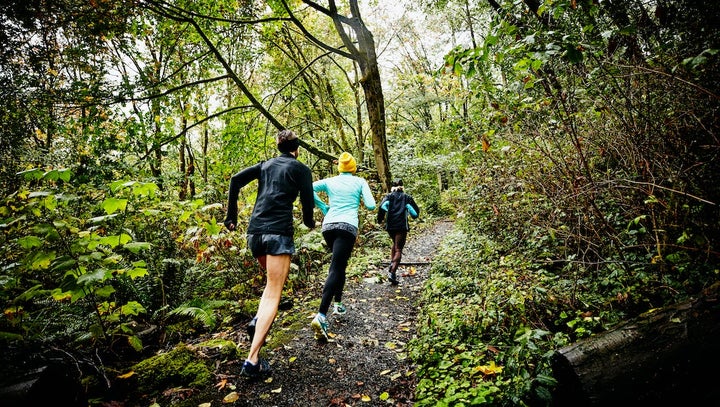Already the most common mental illness in the United States, anxiety levels across the nation sky-rocketed over the past year due to the pandemic and economic crisis. And despite the rapid vaccine rollout and signs of a pre-pandemic world starting to hatch open, we seem to be having a hard time recovering from the ravaging toll COVID-19 had on our mental health. Though many of us are still longing for the day when live, in-person races are once again a regular occurrence, getting out to run regularly is as important as ever. Running, it turns out, may be the closest thing we have to a mental health panacea.
Multiple studies have demonstrated that running and other forms of aerobic exercise have profound abilities to lower anxiety levels. For example, one fascinating study in 2012 by the University of Maryland showed how moderate aerobic exercise may not just help people chill out in the moment, but also to cope with anxiety and stress for an extended period of time post-workout. The researchers found that while both rest and 30 minutes of cycling reduced how much participants were rattled by emotionally arousing images, those who exercised maintained that calm longer than those who simply rested.
Here’s the science behind how running specifically alters the mind to significantly lower anxiety levels and make us more resilient in times of stress.

This is Your Brain on Running
One reason for running’s therapeutic effect is the cocktail of calming neurochemicals it releases. By raising your heart rate, running changes brain chemistry by increasing the availability of anti-anxiety neurotransmitters like serotonin, gamma aminobutyric acid (GABA), brain-derived neurotrophic factor (BDNF), and a group of biochemicals called endocannabinoids — substances that latch onto the same neurological receptors as THC, producing the calming high one gets from consuming cannabis.
It’s this last one that is likely primarily responsible for the mild euphoria some get during aerobic exercise known has a runner’s high. Since the 1980s, the intoxicating phenomena was thought to be caused by endorphins, natural opiate painkillers found in higher levels in runners’ bloodstreams. More recently, however, scientists have become skeptical of their effects on mood. Because of their molecular structure, endorphins cannot cross the blood-brain barrier. And now, research published this April demonstrated that runners developed that mellowing buzz even when their bodies’ ability to react to endorphins are blocked. Rather, the study suggested, it’s endocannabinoids that are responsible for the blissful sensation experienced during a run.
David Raichlen, Ph.D., a professor of biological sciences at the University of Southern California who has studied the effects of exercise on the endocannabinoid system, thinks there are two possible explanations for why running increases endocannabinoid levels. One is that the release of endocannabinoids during aerobic exercise might be adaptive for long distance exercise because it acts as an analgesic. The positive mood effects of that may simply be a happy accident. Alternatively he thinks that feeling good might be the end-goal, a neurochemical action that may have evolved to motivate ancient people to engage in aerobic activity for foraging.
“Either way, I think the change in feeling and mood is a result of our evolutionary history of aerobic activity,” he wrote in an email.
Psychological and Physiological Benefits
In addition to the brain chemical highs running elicits, it provides a psychological distraction from stress. According to John J. Ratey, M.D., associate clinical professor of Psychiatry at Harvard Medical School, movement is something we all need in quarantined life because it gives us a thing to do. In his Harvard Health Blog, he notes that one of the ways that exercise lowers anxiety is by activating frontal regions of the brain responsible for executive function. This helps control the amygdala, which reacts to threats to our survival whether they are real or imagined.
“When you’re running, you use more brain cells than any other human activity,” he explains, noting that this benefit is enhanced by running outdoors. “If you’re also having to focus, and pay attention to the change in the environment, looking at rocks and all that kind of stuff, that’s even more of a challenge, and a good stress on the brain.”
He notes that another way that running acts to reduce anxiety is by giving us a sense of control in that particular moment in life and, by doing so, allows us to just “be” in the moment.
“You’re taking charge and not letting the worries from the [internal and external] environment come in,” he says. Particularly right now, with the threat of a virus lurking in the air, passively sitting inside may make us feel threatened, causing toxic stress levels to rise. But we can curb the rise of that anxiety and make our own beneficial stress by exercising.
On a physiological level, Aimee Daramus, Psy.D., a Chicago-based psychotherapist, points out that the increase in VO2 Max levels achieved through consistent running may also contribute to its ability to lower levels of anxiety. She explains that in states of panic or nervousness, your breathing becomes shallow and labored, and those lowered oxygen levels and stress play into one another.
“With running increasing the VO2 Max it might actually be that that is increasing oxygen levels to a point that kind of interrupts that process,” she says.
How to Boost the Therapeutic Effects
Chances are, if you are reading this, you’re already out there running. But here are a few research-backed ways that you can enhance the anxiety-treating effects of your daily run.
Run in Nature

Of course, being able to run out in nature is a huge privilege right now. But if you can find some greenspace to stride through, research shows that it can enhance the calming effects of aerobic exercise. Already, there is a trove of research showing that simply being in green spaces can lower stress hormones, like cortisol, and blood pressure. It’s given way to “restoration theory,” which proposes that time spent in nature offers restorative effects.
So it’s no wonder that exercising in nature also has been found to offer therapeutic benefits. One study in 2013 used mobile electroencephalography (EEG) as a method to record and analyze the emotional experience of a group of walkers in three types of urban environment including a green space setting. Participants took part in a 25 min walk through three different “zones” of Edinburgh. A shopping area, a path through a green space, and a street in a busy commercial area. When the participants moved into the green zone, the researchers found evidence of lower levels of frustration, engagement and arousal, and higher levels of meditation. “This has implications for promoting urban green space as a mood-enhancing environment for walking or for other forms of physical or reflective activity,” the researchers concluded.
In addition to trail running activating more areas of the brain, Ratey points out that being outside has anti-inflammatory effects as well that make us less anxious and more ready to fight any infection that may come along.
The Magic Effort Level
If you want to increase the release of those endocannabinoids that help you chill out, you don’t want to run too easy or too hard. Raichlen points out that when it comes to exercise there is an inverted U-shaped curve, with very low and very high levels of intensity not eliciting a change in endocannabinoids.
“What we’ve found is that exercise at moderate intensities increases circulating endocannabinoid levels and these increases are correlated with improved positive affect following exercise,” explains Raichlen. By “moderate intensity” he means 70-85% of your maximum heart rate, adjusted for age.
You also might want to incorporate high intensity interval training (HIIT) into your runs. A recent study published a few months ago looked at walking as opposed to HIIT, and found that HIIT was better for anxiety and depression, whereas just walking for a longer period of time was better for cognition and memory.
“If you’re an accomplished runner, you’ll want to work in some sprints,” says Ratey. “You’ll want to work in 20 to 30 seconds of very intense running. That gives you even more of a boost in certain areas of the brain that have to do with our emotions.”
But, he notes, if you’d rather go at a nice slow pace, don’t worry, you still get calming benefits.
Stay Connected
There is strong evidence to support that maintaining strong social networks strengthens resilience to stress and adversity. Though it may not be easy or possible during a pandemic, this is what tech is for. If you’re used to running with a person or group, stay connected by phone, FaceTime or email. Schedule to chat with a friend after your run, or, if you’re in a running group or team, set up a group chat to discuss how everyone’s solo training is going.
This is also a good time to tune inward and focus on the intrinsic factors that motivate us to run, outside of any social pressure or competitive events.
“There are certain parts of exercise that we do for other people,” says Daramus. “Once we’re exercising alone we can get rid of that baggage and just be doing what you want to do for you.”
Practice Mindfulness

Ratey says you should also strive to be as present in your run as possible. Before beginning your run, connect with your breath, breathing through your nose deep into your belly. Continue to focus on your breath as you begin your run, bringing yourself into your body (and out of your mind) paying attention to the somatic sensations, sounds, sights, and scents you experience striding along.
“Get into that zone where it starts to seem easy where you’re just in a state of flow and you’re not really thinking about anything else in the physical moment in which you can relax into the run,” suggests Daramus. “That is associated with a lot of the same benefits to the mind and body as meditation.”
While mindfulness, HIIT, and trail running are proven ways to enhance the stress-release effects of running, if they aren’t for you, or if you can’t do them right now, that’s fine. Don’t stress it. Just keep running, and appreciate its therapeutic benefits.


